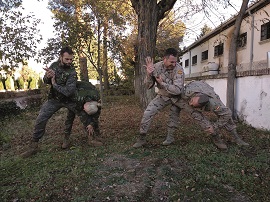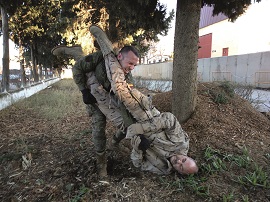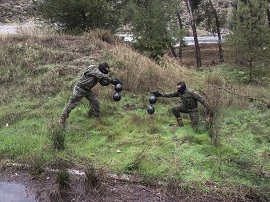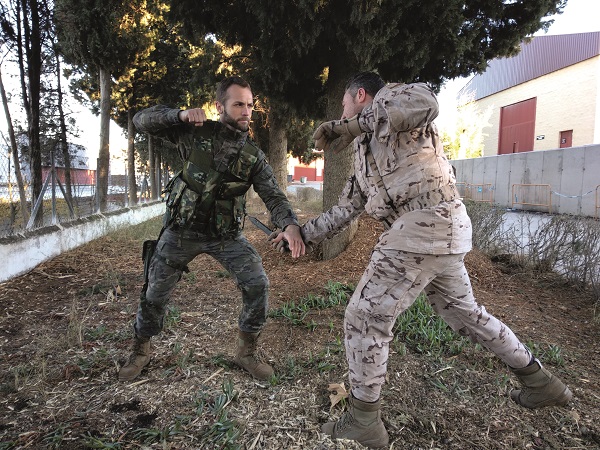It goes further
miércoles 21 de febrero de 2018
Número: 60
Hand-to-Hand Combat and Non-Lethal Intervention (CCC-INL in Spanish)
Hand-to-Hand Combat and Non-Lethal Intervention (CCC-INL in Spanish) is the youngest sport of military interest. In 2014 it took place its fire baptism with the celebration of the 1st Military Trophy of the Spanish Army and, in 2015, it took place the 1st CCC-INL Championship of the Spanish Army. Since then, there has been a great development, as from the three original modalities, ten have been currently reached, thanks to the impulse of the Army Central Committee of Physical Education (JCED in Spanish).
In this report these ten modalities are presented, as captain Lumbreras, technician of the CCC-INL, shows "it is very important to know them in order to achieve a maximum synergy among the instruction and the operarative training, and the competitions". This happens because the CCC-INL is the best allied unit to reach and to assess the efficacy in the preparation of the soldiers for the fulfillment of missions of confrontation, in periods of peace but also in combats.
Currently, the ten competitive modalities are divided into two big groups: Demonstrations and Combat. In the first group, simulations of confrontation with controlled resistance by the opponents' part are included whilst in the second there are real confrontations in which it can be found a series of rules that differentiate them and guarantee the security of the participants.
This way, the chiefs of the units are provided with an excellent tool in order to improve the capacities of Closer Quarter Combat ("Combate de contacto" in Spanish) of the military personnel, "these men and women will have the responsability of going where nobody would like to go to perform missions who nobody would like to perform" adds captain Lumbreras.
Ten Modalities of competitions

Exercise of physical-military instruction. Photo MADOC

Couple exercise. Photo: MADOC

Duel combat. Photo:MADOC
Modalities of competitive demonstrations
1) Physical-Military InstructionThis modality consists in the performance of confronting actions previously defined. It constitutes the first level of training, avoiding the adequate technical and tactic assimilation, with proportional responses and being adjusted to the legal frame, which should chair the whole military performance. Two couples simultaneously compete, which avoids the observation of the simultaneous task conducted by both teams.
2) Binomial Demonstrations
It is based on the performance of both combatants with free and coordinated evolutions of the members of the team.
3) Demonstrations of groups
They have the same base as the binomial demonstrations, but in this case the groups participate in a number which is specified in the draft papers.
4) Non anticipated demonstrationsThey are based on free performances carried out by two or more combatants belonging to the same group. Only one of them knows who is the person attacking first, with which means and who will win by showing a card before the combat starts.
5) Reagent CorridorIt develops the skills concerning the analysis of the situation and inmediate decision of operative teams in an unexpected environment.
Along a marked itinerary, each combatant or team will suffer a series of incidences and they will have to act in an adequate way against them.
Modalities of Combat Competitions
1) Non-lethal intervention combatIt looks for the optimization of the instintive reaction towards a sudden attack. The competition is based on a round of three minutes, divided into three uninterrupted phases of one minute: defense on the ground, grabbing and complete confrontation.
Altogether includes stress inoculation, physical exhaustion, rapid responses...
2) Duel CombatWith one or several rivals from each team, it develops the combat capacity and the use of fire weapons under stressful and exhausting conditions. It is divided in two phases: fire confrontation and duel.
3) Chance CombatIt consists in "one against one" and it develops the skills associated with the analysis of the situation and immediate decisión.
4) Sensory CombatIt allows the development of confrontations in situations with no visibility such as dazzle, dust in the eyes, darkness, wounds, etc.
5) Knife CombatIt develops the skills of confronting with and against knives, existing the possibility of using more weapons and protection equipments to adapt to the necessities of preparation.
UNIDADES DEL EJÉRCITO
- Araba Álava |
- Albacete |
- Alicante |
- Almería |
- Asturias |
- Ávila |
- Badajoz |
- Barcelona |
- Burgos |
- Cáceres |
- Cádiz |
- Cantabria |
- Castellón |
- Ceuta |
- Ciudad Real |
- Córdoba |
- A Coruña |
- Cuenca |
- Girona |
- Granada |
- Guadalajara |
- Gipuzkoa |
- Huelva |
- Huesca |
- Islas Baleares |
- Jaén |
- León |
- Lleida |
- Lugo |
- Madrid |
- Málaga |
- Melilla |
- Murcia |
- Navarra |
- Ourense |
- Palencia |
- Las Palmas |
- Pontevedra |
- La Rioja |
- Salamanca |
- Segovia |
- Sevilla |
- Soria |
- Tarragona |
- Santa Cruz de Tenerife |
- Teruel |
- Toledo |
- Valencia |
- Valladolid |
- Bizkaia |
- Zamora |
- Zaragoza






